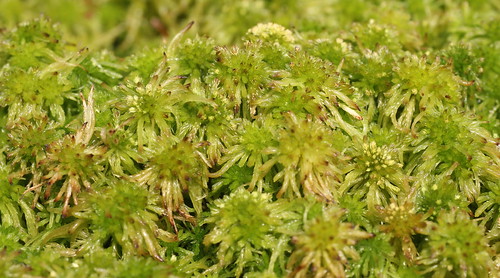Measurements of annual growth of Sphagnum spp. were started in Mukhrino field station (West Siberia) in 2018 as part of the complex program on carbon dynamics in raised bog ecosystems. The main goal of this project is to estimate general characteristics of growth/primary production of different species of Sphagnum in Mukhrino bog.
Totally 57 plots were located along the wooden boardwalks of the field research polygon. Measurements were carried out using modified crancked wire approach (brush-wire) (S. fuscum, S.magellanicum, S.angustifolium, S.papillosum, S.capillifolium) or individual wire ringlets (S. majus, S.jensenii, S.balticum). Part of the plots were under warming experiment conditions (Open Top Chambers).
Totally 3226 measurements were made during 2018-2024 growth seasons.






The project is launched in collaboration with the Institute of Soil Science and Agrochemistry, Novosibirsk.
The database contains 16 fields in a single table:
- occurrenceID — a single measurement individual number
- eventID — plot number
- samplingProtocol — crancked wire vs. individual wire ringlet
- habitat — vegetation
- fieldNotes — water level below the surface, cm (measured once for each plot in 2018)
- decimalLatitude — coordinate of the plot
- decimalLongitude — coordinate of the plot
- Datum — geodetic datum of the coordinate
- coordinateUncertaintyInMeters — coordinate uncertainty, m
- scientificName — Sphagnum species
- organismQuantity — growth increment, cm
- organismQuantityType
- eventDate — date range of growth period
- Year — year of growth period
- kingdom — Plantae
- eventRemarks — any field notes on measurements biases.

Sampling methods
57 plots were located alonside the wooden boardwalk of the station research polygon. Each plot contained minimum 10 replicate measurements of a single species. Each species was measured in several plots (2-6) to cover spacial heterogenity. Totally 8 species of Sphagnum were studied for annual growth/primary production. The plots were located in natural as well as in altered temperature conditions (30 plots with S. balticum were included in climate manipulation experiment, Open Top Chambers). The installation of the markings was carried out in October, and the measurements were made a year after (no seasonal dynamics was measured between these dates). The database presents results of three years of observations.
Crancked wire (its modified wire-brush) method was used to measure annual growth of up-growing species (S. fuscum, S.magellanicum, S.angustifolium, S.capillifolium, S.papillosum). Individual wire ringlets approach was used the measure side-growing species (S.balticum, S.majus, S.jensenii). The markings were installed in October to start measuremets early from the spring in the next year. The measurements were made a year after (in September-October).
Each species of Sphagnum was measured in several plots to cover spacial heterogenity. Each plot contained min 10 replicate markings to cover variability as well as occasional lost of the markings. The measurements were made using a ruler, with approximate accurasy of the method being 0.5 cm.
Measurements of up-growing species were made using modified crancked wire method (brush-wire). The wire covered by plastic sheath was used to prevent corrosion, as well as other inert and stabile materials were used to make the brush and the flags. The wire-brush was inserted between Sphagnum capitulas using a cocktail tube so that exactly 10 cm of wire was exposed above the capitulas. The detailes of brush-wires preparation showed in pictures and videos: https://www.flickr.com/photos/mukhrinostation/albums/72157667768367903
The measurements of annual growth were made by a ruler of the exposed part of the wire, with subsequent re-calculation as follows:
Sphagnum annual growth = 10 cm — measurement of wire above the capitulas, cm.
Measurements of side-growing species were made using the individual wire rings. The inert wire was used to prevent corrosion and Sphagnum dying off. By 10 individual rings were attached to a wooden pole with a flag to trace the markings after the vegetation season will pass. Each ring was attached exactly under the capitula of each Sphagnum individual. The details of rings prepartaion showed in pictures and videos: https://www.flickr.com/photos/mukhrinostation/albums/72157667768367903
The measurements of annual growth were made by a ruler of the incremental growth between a ring and a Sphagnum capitula.
To calculate total spatial primary production, the Sphagnum shoot density was measured on each plot after growth increment was measured. A frame 5 cm2 was used to extract a sample of exact area, which was packed in a zip bag, labeled and transferred to the laboratory. The number of sphagnum shoots in each sample was counted in the laboratory and filled in the database.
Published papers:
Kosykh N.P., Koronatova N.G., Lapshina E.D., Filippova N.V., Vishnyakova E.K., Stepanova V.A. 2017. Linear growth and production of Sphagnum mosses in the middle taiga zone of West Siberia // Environmental dynamics and global climate change. V. 8 (1). P. 3-13. (Pdf)
Filippova NV, Kosykh NP, Filippov IV, Mescheryakova AV, 2023. Annual growth and primary production of sphagnum in raised bog “Mukhrino” (four-years observation: 2019-2022)//Environmental dynamics and global climate change, 14/1, https://doi.org/10.18822/edgcc472141
Last update: 25.12.2024

